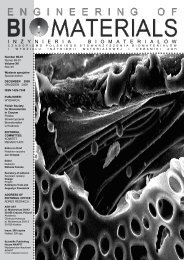69-72 - Polskie Stowarzyszenie BiomateriaÅów
69-72 - Polskie Stowarzyszenie BiomateriaÅów
69-72 - Polskie Stowarzyszenie BiomateriaÅów
You also want an ePaper? Increase the reach of your titles
YUMPU automatically turns print PDFs into web optimized ePapers that Google loves.
26<br />
WPŁYW PROCESU TARCIA NA<br />
STRUKTURĘ MATERIAŁÓW<br />
KOMPOZYTOWYCH<br />
NA STAŁE WYPEŁNIENIA<br />
STOMATOLOGICZNE<br />
Joanna Mystkowska*, Jan Ryszard Dąbrowski<br />
Politechnika Białostocka, Wydział Mechaniczny,<br />
ul. Wiejska 45c, 15-351 Białystok,<br />
*E-mail: joasia@pb.bialystok.pl<br />
Streszczenie<br />
W pracy przedstawiono wyniki badań wpływu<br />
procesu tarcia na strukturę materiałów kompozytowych<br />
na stałe wypełnienia stomatologiczne. Badane<br />
kompozyty zawierały fluorowane szkło oraz różne<br />
modyfikatory tarcia. Procesy tarcia przeprowadzono<br />
w specjalnie skonstruowanym symulatorze tarcia.<br />
Obserwowano wpływ wzajemnego oddziaływania<br />
pomiędzy cząstkami napełniaczy a żywicą organiczną<br />
na właściwości tribologiczne otrzymanych próbek materiałów.<br />
Powierzchnię tarcia z widocznymi cząstkami<br />
zużycia analizowano przy wykorzystania programu do<br />
analizy obrazu.<br />
Słowa kluczowe: tarcie, modyfikatory tarcia, kompozyty<br />
stomatologiczne<br />
[Inżynieria Biomateriałów, <strong>69</strong>-<strong>72</strong>, (2007), 26-29]<br />
Wprowadzenie<br />
Zużycie materiałów stomatologicznych jest jednym<br />
z głównych problemów dotyczących niemalże każdego<br />
rodzaju wypełnienia [1]. Docelowym zadaniem badań<br />
obejmujących nowoczesne materiały stomatologiczne jest<br />
otrzymanie takiego materiału, który mógłby być używany do<br />
wszystkich rodzajów ubytków i podobnie jak amalgamat,<br />
wykazywać optymalną odporność na zużycie. Ostatnio,<br />
sporo uwagi poświęca się badaniom nad materiałami zastępującymi<br />
amalgamaty. Największe nadzieje związane<br />
z otrzymaniem takiego materiału pokładane są w kompozytowych<br />
materiałach na stałe wypełnienia stomatologiczne<br />
[2]. Prowadzi się więc liczne próby otrzymania kompozytów<br />
cechujących się niskim współczynnikiem tarcia i małym<br />
zużyciem.<br />
W celu obniżenia zużycia i współczynnika tarcia materiałów<br />
stomatologicznych, intensywnie modyfikuje się skład<br />
stosowanych napełniaczy. Znaczna poprawa ich właściwości<br />
tribologicznych może być uzyskana wskutek zastosowania<br />
odpowiedniego napełniacza, zwanego modyfikatorem tarcia.<br />
Mówi się, że właściwości kompozytów głównie zależą<br />
od typu, rozmiaru, rozmieszczenia i zawartości stosowanego<br />
napełniacza [3]. Skład matrycy organicznej również odgrywa<br />
ważną funkcję przy formowaniu końcowych właściwości<br />
materiału. W przypadku nieorganicznych napełniaczy zużycie<br />
jest prawdopodobnie związane z ilością naniesionego<br />
na ich powierzchnię silanowego środka wiążącego [4].<br />
Kompozyty z największą zawartością środka wiążącego<br />
cechuje największa prędkość zużywania [5].<br />
Celem niniejszej pracy było porównanie właściwości<br />
materiałów kompozytowych na stałe wypełnienia stomatologiczne<br />
po procesach tarcia z zastosowaniem dwóch organicznych<br />
i dwóch nieorganicznych napełniaczy proszkowych.<br />
THE INFLUENCE OF FRICTION<br />
PROCESS ON THE STRUCTURE<br />
OF COMPOSITE MATERIALS FOR<br />
DENTAL FILLINGS<br />
Joanna Mystkowska*, Jan Ryszard Dąbrowski<br />
Bialystok Technical University,<br />
Faculty of Mechanical Engineering<br />
45c, Wiejska str., 15-351 Bialystok,<br />
*E-mail: joasia@pb.bialystok.pl<br />
Abstract<br />
The paper presents results of research of the influence<br />
of friction process on the structure of composite<br />
materials for dental fillings. The investigated composites<br />
contain a fluoridated filler and different powder<br />
fillers. Wear tests were carried out by means of special<br />
tribotester. The interaction between the filler particles<br />
and organic matrix and its influence on the tribological<br />
behavior of prepared specimens were observed. The<br />
friction surface with the wear particles was observed<br />
by means of SEM and the pictures were analyzed by<br />
a computer image editing software.<br />
Keywords: Friction, friction modifiers, dental<br />
composites.<br />
[Engineering of Biomaterials, <strong>69</strong>-<strong>72</strong>, (2007), 26-29]<br />
Introduction<br />
The wear of dental materials is one of the major problems<br />
concerning almost every kind of dental filling [1]. The ultimate<br />
goal of advanced dental material research is to produce a<br />
material that can be used in all circumstances as an amalgam<br />
replacement material which revealed an optimal wear<br />
resistance. In recent years, a lot of effort is focused on the<br />
development of amalgam replacement materials. The best<br />
way of developing such a material is connecting with composite<br />
materials for dental fillings [2]. Thus, a big interest in<br />
composite materials for dental fillings, in which low friction<br />
and low wear must be provided, is very significant.<br />
In order to reduce the wear and coefficient friction of<br />
analyzed materials, the composition of applied filler is extremaly<br />
modified. Evident improvement of the tribological<br />
properties of a material can be obtained by using suitable<br />
filler, called friction modifier. It is said that the properties of<br />
composites are mainly dependent on the type, size, spacing<br />
and volume fraction of the utility filler [3]. The constitution<br />
of organic matrix also plays an important function in forming<br />
the final properties of material. In the case of inorganic<br />
fillers the wear of material is probably connected with the<br />
amount of damage caused to silane coupling agent [4].<br />
The composites with the highest degree of coupling show<br />
the highest wear rate [5].<br />
The aim of this study was to compare the properties<br />
of composite materials for dental fillings consisting of two<br />
organic fillers with those obtained with an inorganic friction<br />
modifier.<br />
Materials and methods<br />
In this work five ceramic-polymer microfilled composites<br />
containing friction modifiers were tribologicaly tested.













